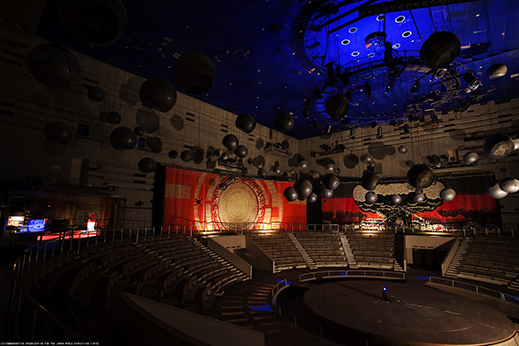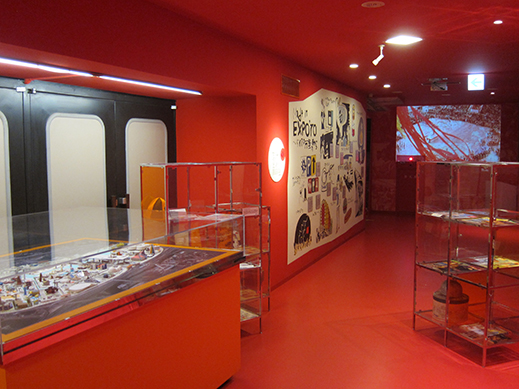 |
Focus features two in-depth reviews each month of fine art, architecture and design exhibitions and events at art museums, galleries and alternative spaces around Japan. The contributors are non-Japanese residents of Japan. |
|
|
 |
 |
 |
The Future Is the Past at Expo '70 Pavilion
Christopher Stephens |
 |
Expo '70 Pavilion with Taro Okamoto's Tower of the Sun off in the distance at far right. |
The Great Exhibition, held at the Crystal Palace in London in 1851, marked the start of a string of world's fairs designed to introduce the best and the latest in industry and culture. At the time, Japan's policy of national seclusion prevented any contact with the outside world, and it would be more than 100 years before the country hosted its and Asia's first international exposition. Held over a six-month period in the northern suburbs of Osaka, Expo '70 attracted over 64 million visitors (roughly half the nation's population), providing many Japanese with their first direct exposure to foreign people (outbound travel for purposes other than business was prohibited until 1964). A national government undertaking, the expo heralded Japan's postwar economic resurgence and emergence as a technological leader.
Today, the sprawling site, known as Expo '70 Commemorative Park, is home to a Japanese garden, the Japan Folk Crafts Museum, and the National Museum of Ethnology. Nearly all of the original structures have been demolished, with the exception of the former Steel Pavilion (designed by Kunio Maekawa for the Japan Iron and Steel Federation), which was reopened in 2010 on the event's 40th anniversary as Expo '70 Pavilion. Promising visitors a trip back in time, the facility offers a (free) permanent exhibition that details the planning, construction, and operation of the expo with films, photographs, and models. There are also special exhibits and talk events on expo-related topics. The current show, The Legacy of Expo '70, focusing on pavilion architecture, was curated by Shinya Hashizume, the pavilion's director and a prolific historian of Osaka modernism.
 |
|
Exhibition view with one of the dozens of uniforms worn by the expo's "companion girls" on the left. |
Among the permanent displays is an intriguing list of expo statistics such as highest one-day attendance: 835,832 people; number of toilets: 2,755; number of coin lockers: approximately 4,000; number of visits by members of the Imperial Household: 63; number of lost children: 48,139; number of babies born: 1; number of people who received medical attention: 86,332; average daily electricity consumed: 725,000 kWh (the same amount needed to power all of Nara Prefecture for a day); and amount of garbage generated: 19,353 tons (4,838 four-ton trucks' worth). General admission tickets were priced at 800 yen and entitled the holder to stay from 9:00 a.m. to 10:30 p.m. -- a bit steep considering that at the time, a pack of cigarettes went for 50 yen and a can of beer 140 yen.
No data is available on waiting time, but by all accounts it took several hours to get into the more popular pavilions. A record 62 countries participated and accounted for 76 of the 116 pavilions -- some, like the U.S. and Germany, had multiple venues. The abiding memory for most visitors was the moon rock, one of many that were retrieved by Apollo astronauts the previous year and distributed by the U.S. to allied governments (though the sample given to the Netherlands was later found to be a fake). Despite the strong American presence, the Soviet Pavilion, a huge red-and-white crested wave with a hammer-and-sickle insignia on top and Tchaikovsky's piano inside, drew the biggest crowds.
 |
|
Space Theater Hall, with a display area visible on the left and tapestries in the rear. |
The master plan for the expo was overseen by architect Kenzo Tange, best known for Hiroshima Peace Memorial Park and for the Yoyogi National Gymnasium built for the 1964 Tokyo Olympics. The latest trends in architecture were also on display at three buildings designed by Kisho Kurokawa, a prominent figure in the Metabolist movement of the '60s. These included the Capsule House theme pavilion, which outlined Kurokawa's vision for self-contained living and working modules that could be inexpensively manufactured, stacked up like blocks, and rearranged as needed. This concept became a reality two years later with the construction of the Nakagin Capsule Tower in Tokyo.
In the center of Expo '70 Pavilion is the Space Theater Hall, a circular performance venue equipped with a revolving stage and what at the time was a state-of-the-art audio and lighting system. A glass booth in one corner provides a commanding view of the space and an audiovisual presentation on three programs of music produced for the event by Toru Takemitsu, Yuji Takahashi, and the Greek composer Iannis Xenakis. Equipped with over 1,000 speakers in the ceiling, walls, and floor, the hall hosted performances of koto music, Bunraku puppet theater, Buddhist chanting, and Noh drama. More experimental offerings, such as Takemitsu's Crossing, were accompanied by a light show with red and blue lasers and mirrors. Hanging in the rear of the hall are two enormous Nishijin tapestries, the first (Tower of Joy) featuring a sun motif symbolizing human wisdom, sincerity, and trust, and the second (Tower of Sorrow) depicting a mushroom cloud and the Hiroshima Peace Memorial's A-Bomb Dome.
 |
|
Exhibition view with a scale model of the expo site on the left and a mural of innovations on the wall. |
Another corner of the hall is devoted to the artist Taro Okamoto and his design for the Theme Pavilion, the physical and conceptual heart of Expo '70. Exemplifying the event's theme, "Progress and Harmony for Mankind," the huge indoor/outdoor complex was divided into three zones: "The World of Origin: The Mystery of Life" (an underground space representing the past), "The World of Harmony: Energy Today" (a ground-level space representing the present), and "The World of Progress: Separation and Unification" (an aerial space representing the future). At the center was Okamoto's 70-meter-tall concrete sculpture Tower of the Sun, a beloved emblem of the expo that has since come to stand for Osaka as a whole. In addition to a large gold face with searchlight eyes (the future), the bird-like creature has a sun with human features carved into its torso (the present) and a black sun in a circle of green flames on its back (the past). Inside the tower, but closed to the public, is an installation by Okamoto called The Tree of Life. Here, some 300 organisms from every phase of the Earth's four-billion-year history are perched on the fluorescent limbs of a concrete tree, leading to some small human figures. As visitors made their way up via escalator or elevator, they were treated to sounds and music that corresponded to every evolutionary phase, beginning with a song from the depths of the Earth and ending with a celestial choir. (The tower is currently undergoing structural repairs and is scheduled to reopen on a regular basis next spring.)
 |
|
Entrance to the Taro Okamoto exhibit with small displays devoted to individual pavilions on the right. |
Like all world's fairs, the Osaka Expo unveiled a host of new innovations purporting to offer a glimpse into the future. Chief among these was the Dream Telephone, a wireless device housed in a transparent egg-shaped chair and suspended from the ceiling that allowed visitors to make a free three-minute call anywhere in the world; the Ultrasonic Bath (or "Human Washing Machine"), a streamlined fiberglass capsule with clear sides equipped with massage balls and ultrasound that washed, massaged, and dried the user's body in a fully-automated 15-minute cycle; and Japan's first fast-food outlet, Kentucky Fried Chicken (McDonald's arrived the following year). There's nothing like a look back at the dream of a future that never was to trigger the nostalgia gland, and if it's a fantastic trip to the past you're after, there are few places like Expo '70 Pavilion.
All images provided by Expo '70 Pavilion.
|
 |
 |
Christopher Stephens
Christopher Stephens has lived in the Kansai region for over 25 years. In addition to appearing in numerous catalogues for museums and art events throughout Japan, his translations on art and architecture have accompanied exhibitions in Spain, Germany, Switzerland, Italy, Belgium, South Korea, and the U.S. His recent published work includes From Postwar to Postmodern: Art in Japan 1945-1989: Primary Documents (MoMA Primary Documents, 2012) and Gutai: Splendid Playground (Solomon R. Guggenheim Museum, 2013). |
|
 |
|